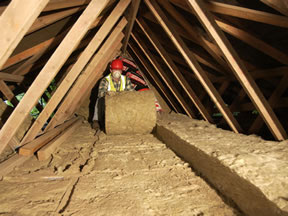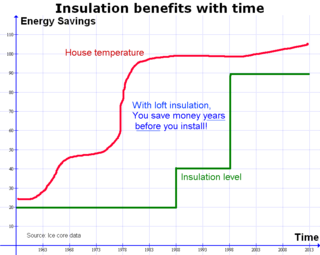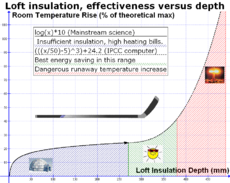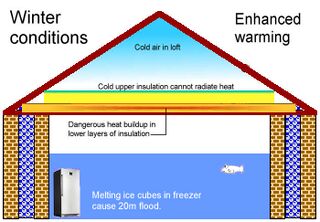HowTo:Insulate your loft
Purpose
Scientists have observed that a widespread uptake of loft insulation by the public always precedes an increase in the price of heating fuel. Hence by insulating your loft you are allowing the fuel company to increase their profits. This is a commendable action since it keeps the carbon traders getting their bonuses. This is similar in nature to the mechanism whereby increases in the atmosphere's carbon dioxide content causes temperatures to rise in advance of the CO2 increase.
In the following century you are more than likely to need extra loft insulation, since anthropological global warming has caused all of the hot air to migrate into the upper atmosphere. This has made things a lot colder down at ground level.
You will need
- Rolls of fiberglass matting
- Dust mask
- Gloves
- Ladder
- Overalls
- Crawl boards
- Floodlight (if no loft lighting present)
- Knife
- Large scissors
- Ruler
- Cookie jar with model house and thermometer (essential for safety checks)
- Thermos of hot coffee if you're trying to fit insulation with 10 metres of snow outside.
Installation
Take the rolls of insulation into the loft. Cut the outer wrapping and unroll them. If necessary, use the scissors to trim the insulation so it fits between the rafters. Lay it on the upper surface of the drywall ceiling. Easy! Sit back and congratulate yourself on a job well done. Then, spend two hours trying to wash all that itchy fiberglass out of your hair.
Points to watch
- If possible, route power cables over the top of the insulation, not below, so when those taped-up bits spark they won't set fire to the fiberglass.
- Remember to place a row of buckets under each water pipe or tank which is above the insulation.
- Allow a space of 100mm around the edges of the loft, so as not to block any mouse holes. Otherwise you might have the RSPCA after you.
Amount of insulation needed
- Q: How deep should the insulation be?
- A: 270mm is adequate. It is vital for safety that you fit no more than 380mm.
To work out how many rolls of insulation you need to achieve 270mm depth, multiply the length of your loft by its width, then add 20, and take away the number of rolls you first thought of. Divide by five and add 20. You now know how many to buy. This task is not suitable for guesswork. Trying to work out how much insulation you need in feet and Inches, cubits, furlongs etc. indicates future genetic obsolescence.
Caution
Never step on drywall ceiling. It cannot take your weight. Walk along rafters, or use crawl boards placed on top of rafters. Under no circumstances allow your polar bear to follow you into the loft. They can become claustrophobic and lash out. Many insulation jobs have failed for this very reason.
Danger (must read!)
Scientists have shown that the relationship between insulation thickness and heat retention is a logarithmic one. Up to a certain depth the insulation will have little or no effect. Beyond this depth, any further additions will have a rapidly-increasing, runaway effect of warming. In fact, This is almost exactly like the effect of carbon dioxide on the Earth's temperature.
Studies show that pre-industrial houses were fitted with 270mm of loft insulation, and this gave rise to stable temperatures. However, since the 1960's there have been dramatic rises in the amounts of insulation installed, with the typical house of the early 21st Century having 380mm. This situation is getting dangerous, in that any further increase in loft insulation could lead to runaway temperatures in the rooms beneath, possibly to as high as 160C, resulting in the death of all inhabitants from heatstroke. Furthermore, once this situation develops it may make no odds if the excess insulation is removed from the loft; in spite of this the house temperatures may still continue to increase. Thus, we are approaching a point of no return, and if we continue fitting ever-deeper loft insulation we just don't know what disastrous effects this may have. Thus, be extremely careful not to fit more than 380mm insulation.
A film entitled "An Insulation Truth" has been sponsored by former US Vice President Al Gore in an attempt to sensationalize the risks involved in fitting too much loft insulation. This has won a Nobel prize for protecting the public from danger. We suggest you watch it and take heed before fitting insulation.
Some have questioned the wisdom of this film's advice, quoting examples of houses with 500mm or more of insulation which have suffered no disasters. So far. There people are plain wrong. Let me emphasize that. They are WRONG. Listen, they are not scientists, and therefore are not qualified to comment. We are. What they do not understand, and do not take into account, is that 500mm of insulation might be OK in summer when the loft is warm, but when the loft is cold in winter the insulation will suddenly become many times more effective. This happens because cold air in the upper regions of the loft cools the top layer of insulation, and this makes it impossible for the lower levels of insulation to give off their stored heat. Thus, come colder weather the house will likely suffer a dangerous, runaway increase in room temperature. It may even explode.
An additional dangerous effect of too much insulation is that the weight compresses the lower levels of fiberglass, and this compressed material is able to absorb more different kinds of heat than the uncompressed stuff on top. Thus, more heat is forced back into the room below instead of exiting safely into the atmosphere. Again, a situation which can quickly get out of control.
So, be aware that we know what we're talking about here, and you don't. There is NO DEBATE that too much insulation is dangerous. It is a DONE DEAL.
Benefits
Insulating your loft brings many advantages. Not least is that you will experience warmer rooms, starting several decades before you fit the insulation. Thus, the benefits begin long before you even do the job. Though, the greatest benefit will be the boost in self-esteem you get from knowing the you are now officially a 'Greenie' and can tell all your friends about how you, singlehandedly, made-up for the failure of the Durban talks. Then, of course there is the $100bn subsidy per house, which is not to be sniffed-at.
You may note that since the resulting fuel price rise plus the cost of the fiberglass will easily cancel out any saving you make from using less heat, you will suffer a net loss of money. Do not despair though. The main point is that by doing this you will be seen to be Green, and these days that is by far the most important thing to be.
Just don't overdo it.
Also see
| Featured version: 10 January 2013 | |
| This article has been featured on the main page. — You can vote for or nominate your favourite articles at Uncyclopedia:VFH. | |





